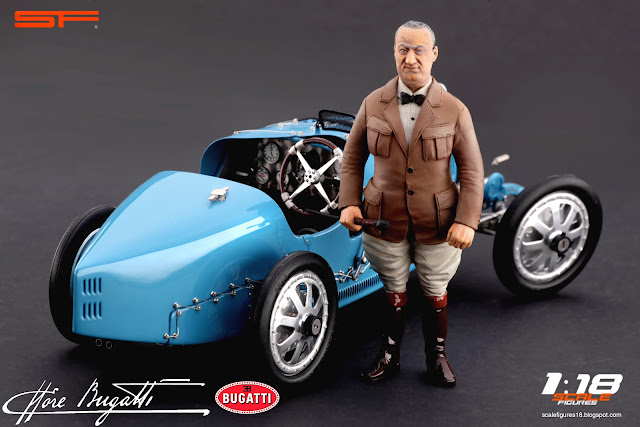Ettore Arco Isidoro Bugatti (1881-1947)
Ettore Bugatti was the legendary engineer and
designer of the most famous Bugatti sports cars, the founder of the
Bugatti car manufacturing plant, and one of the forefathers of modern
automobile engineering.
Ettore Arco Isidoro Bugatti was born in Milan on 15 September 1881 and at the age of 17 he joined as an apprentice the bicycle and tricycle manufacturing plant Prinetti & Stucchi, where he built his first engine-driven tricycle with two De Dion engines. This was followed by his first automobile in 1900, financed by Count Gulinelli; the construction was so remarkable that it won an award at an internationally renowned industry fair in Milan. In 1901, Ettore moved to Niederbron in Alsace to take up the job of technical director of De Dietrich’s automobile manufacturing plant; since he was still underage, his father Carlo Bugatti signed the contract in his name on 2 July 1902. Working for De Dietrich, Ettore developed new automobile models and entered numerous races. After he left the company in 1904 his career then continued with a string of positions in automobile development and construction.
1907 was a pivotal year in Ettore Bugatti’s life. He married Barbara Maria Giuseppina Mascherpa, with whom he had two sons and two daughters, and then on 1 September he signed on with the gas-engine plant Gasmotoren-Fabrik Deutz in Cologne. In his basement in Cologne-Mülheim, Bugatti developed an extremely lightweight car, which soon afterwards he started producing under his own name. In 1909 he prematurely ended the contract with Deutz, collected his severance pay, and leased a disused dyeworks in Molsheim, Alsace. Thus began production of the Bugatti T13, which continued to expand over the years. For Peugeot, Ettore developed the Bébé Peugeot, and further licenses for Bugatti designs were bought by Rabag (Düsseldorf), Diatto (Turin), and Crossley (Manchester).
The outbreak of World War I signaled another turning point in Bugatti’s life. The family moved first to Milan and then to Paris, where Ettore designed an 8-cylinder and a 16-cylinder airplane engine. After the war he moved back to Molsheim (now French territory) and re-opened his plant at its original location. He continued to build light, elegant sports cars that won him victories at Le Mans in 1920 and Brescia the following year – and three more times after that. Thus began a winning streak that lasted until 1925 and garnered numerous triumphs (412 according to Ettore Bugatti’s rather idiosyncratic count). In the early 1930s, Ettore launched the production of motorized railcars – “Autorails” – that featured Royale engines, and in 1934 he commenced production of the Bugatti Type 57, the first car with a chassis designed by Ettore’s son Jean.
Ettore Arco Isidoro Bugatti was born in Milan on 15 September 1881 and at the age of 17 he joined as an apprentice the bicycle and tricycle manufacturing plant Prinetti & Stucchi, where he built his first engine-driven tricycle with two De Dion engines. This was followed by his first automobile in 1900, financed by Count Gulinelli; the construction was so remarkable that it won an award at an internationally renowned industry fair in Milan. In 1901, Ettore moved to Niederbron in Alsace to take up the job of technical director of De Dietrich’s automobile manufacturing plant; since he was still underage, his father Carlo Bugatti signed the contract in his name on 2 July 1902. Working for De Dietrich, Ettore developed new automobile models and entered numerous races. After he left the company in 1904 his career then continued with a string of positions in automobile development and construction.
1907 was a pivotal year in Ettore Bugatti’s life. He married Barbara Maria Giuseppina Mascherpa, with whom he had two sons and two daughters, and then on 1 September he signed on with the gas-engine plant Gasmotoren-Fabrik Deutz in Cologne. In his basement in Cologne-Mülheim, Bugatti developed an extremely lightweight car, which soon afterwards he started producing under his own name. In 1909 he prematurely ended the contract with Deutz, collected his severance pay, and leased a disused dyeworks in Molsheim, Alsace. Thus began production of the Bugatti T13, which continued to expand over the years. For Peugeot, Ettore developed the Bébé Peugeot, and further licenses for Bugatti designs were bought by Rabag (Düsseldorf), Diatto (Turin), and Crossley (Manchester).
The outbreak of World War I signaled another turning point in Bugatti’s life. The family moved first to Milan and then to Paris, where Ettore designed an 8-cylinder and a 16-cylinder airplane engine. After the war he moved back to Molsheim (now French territory) and re-opened his plant at its original location. He continued to build light, elegant sports cars that won him victories at Le Mans in 1920 and Brescia the following year – and three more times after that. Thus began a winning streak that lasted until 1925 and garnered numerous triumphs (412 according to Ettore Bugatti’s rather idiosyncratic count). In the early 1930s, Ettore launched the production of motorized railcars – “Autorails” – that featured Royale engines, and in 1934 he commenced production of the Bugatti Type 57, the first car with a chassis designed by Ettore’s son Jean.
Two years later production at Molsheim ground
to a halt as the result of a national strike. Disappointed in his
employees and oppressed by mounting debt, Ettore Bugatti moved to Paris,
leaving management of the Molsheim plant to his son Jean. After the
outbreak of World War II, the Bugatti production facilities were
temporarily relocated to Bordeaux. In 1939, Jean was killed in a car
accident and Ettore was forced by the Nazi occupiers to sell his
company. After the death of his first wife Barbara, he married Geneviéve
Marguerite Delcuze, with whom he had a son and a daughter. Ettore
Bugatti died in Paris on 21 August 1947.









Комментариев нет:
Отправить комментарий